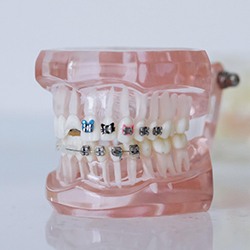Traditional Braces – Dallas, TX
Trusted Appliances to Bring Teeth Into Alignment
Avion Dental & Orthodontics is here to help patients of all ages achieve straighter, healthier smiles with braces in Dallas. Our in-office, board-certified orthodontist, Dr. Sfogliano, will help you or your child navigate the process of preparing for and wearing traditional braces from our Dallas, TX orthodontist as well as discuss what you can expect when finished with your orthodontic treatment. Because the metal bracket and wire system have helped millions see a dramatic and life-changing difference in their smile, our team at Avion Dental & Orthodontics looks forward to helping you achieve the same goal. Contact us today to find out how you can schedule an initial appointment with Dr. Sfogliano.
Why Choose Avion Dental & Orthodontics for Traditional Braces?
- Luca Sfogliano is a board-certified orthodontist on-staff
- Flexible in-office payment plan available
- Late evening appointments for convenient scheduling
How Do Traditional Braces Work?

Traditional braces are the most common method of orthodontic treatment used by professionals throughout the world. Designed to address problems of overcrowding, gapped or crooked teeth, or even serious bite alignment issues (i.e., overbite, underbite, crossbite, open bite), children, teens, and adults can achieve their smile goals with the help of this metal bracket and wire system.
As an orthodontist near me, Dr. Sfogliano will cement the metal brackets to the surfaces of your teeth before threading an archwire through each bracket. Once firmly in place, the two components will work together to apply pressure to your teeth, causing them to shift in the right direction over a designated period of time.
With traditional braces, you are required to maintain follow-up appointments with our team to allow for the adjusting and replacing of your archwire. As your smile develops, it will be necessary to continue applying adequate pressure to your teeth to ensure they reach their final destination and achieve the necessary results.
Who is a Good Candidate?

No matter the age, school-aged children, teenagers, and adults are capable of moving forward with traditional braces. Although some individuals (i.e., mature teens and adults) may prefer a more subtle approach to orthodontics (i.e., clear aligners), metal braces are a tried-and-true option that lends beautiful results.
But before you can move forward with treatment, our orthodontist will perform a thorough evaluation of your smile to determine the severity of the problem and how best to reach the results you desire. It is necessary that you show no signs of tooth decay or gum disease, as these can cause delays once your braces are put into place. Should these be evident during your consultation, you will need to seek appropriate treatment to address these problems first.
How to Take Care of Your Braces

Once your braces are affixed to your teeth, you must know how to maintain them throughout treatment. Because your teeth are still vulnerable to decay, cavities, and gum disease, you’ll need to make sure you are keeping up with your oral hygiene routine daily. Some helpful tips to make this easier include:
- Using an interdental brush to get underneath the wire and between brackets for a more thorough clean
- Purchasing a water irrigator to make flossing between your teeth easier
- Brushing after every meal to minimize the potential of food particles becoming stuck in your braces
You will also want to avoid hard, crunchy foods, as these can not only damage your teeth but also cause brackets to break and wires to poke out and irritate your soft oral tissues.
Understanding the Cost of Traditional Braces

Many people associate braces with a hefty price tag, but they are more affordable than you might realize. Various factors affect the cost of traditional braces in Dallas, but we strive to keep them affordable for everyone. After examining your mouth and learning more about your preferences, we’ll create a personalized estimate and review your payment options. Whether you missed your chance for braces as a child, or your teeth have moved over the years, we have the solutions you need to keep a straight smile within your budget.
Factors That Affect the Cost of Traditional Braces

No two orthodontic cases are the same. Therefore, there isn’t a set fee for braces because there’s not a one-size-fits-all solution. Many factors influence the cost of your treatment, which can include:
- Preparatory Procedures: It’s not uncommon to require a little prep work before getting braces, like a cleaning, filling, or gum disease treatment.
- Type of Braces: You can choose from a variety of materials and types of braces to find the solution to fit your needs.
- Complexity of Case: Major tooth movements will require a longer treatment, which can affect the cost.
- Number of Arches: Single arch treatment is rare, so you can expect to pay for braces on the top and bottom teeth.
Don’t worry, you will know exactly what you will have to pay before committing to anything, so you won’t be surprised by any unexpected fees.
Professional Braces vs. "DIY" Braces: Which Costs More?

Mail-order braces have become a popular method of fixing bite and alignment issues; however, there are risks involved. Although they seem convenient and affordable, they can cost more down the road because you aren’t under the supervision of a dental professional. DIY braces don’t even require a consultation to ensure you are a candidate for orthodontics. In addition, you take an impression of your mouth on your own. Minor errors with the impression can cause your teeth to be moved incorrectly. Since you won’t see a dentist at all during your treatment, issues can be overlooked until it leads to costly damage, which can include tooth loss. You will eliminate the risk of any preventable issues by investing in the experience and qualifications of a trained professional.
Does Dental Insurance Cover Braces?

Every insurance plan differs, but many policies offer coverage for orthodontics. After meeting your deductible, you have access to a lifetime limit to offset the amount you pay out-of-pocket for braces. A member of our team will work on your behalf with your dental insurance to maximize your benefits.
Options for Making Braces Affordable

Besides using your dental insurance, we offer various methods to pay for a straight smile, including:
- Traditional Payments: We accept all traditional payment methods, including cash, checks, and credit cards.
- Third-Party Financing: Pay for your braces using monthly installments with little to no interest.
- Promotions: Ask us about any ongoing specials.
- VIP Program: Benefit from reduced rates after joining our VIP membership programs.
If you have any questions about your payment options, contact our office today to speak with a member of our team.
Traditional Braces FAQs
Am I too old to get braces?
If you missed your chance for braces as a child or your teeth have moved over the years, you are never too old for braces. 1 in 5 orthodontic patients is over the age of 18. While there isn’t an age limit for braces, your teeth are more firmly embedded in your jaw than younger patients. Therefore, it can take a little longer to move your teeth. Your dentist will examine your mouth to ensure your teeth and jawbone are healthy before beginning any treatment. It’s not unusual to require a little prep work, like fillings or gum disease treatment. Although it’s never too late to invest in a healthy, straight smile, most dental plans only cover orthodontics for children; however, we offer various payment options to keep your treatment affordable.
How long do traditional braces take?
Treatment with traditional braces can take anywhere from 1 to 3 years; however, every situation differs. Each mouth is unique, so the duration depends on various factors, like your age, the complexity of alignment issues, and treatment compliance. You can ensure there aren’t any delays by following your dentist’s instructions and maintaining your regular appointments. Commit to your oral hygiene to avoid any dental problems that can lengthen your treatment, like decay.
Can I get braces on just the top or bottom?
Single arch treatment is possible, but it is rarely recommended. Repositioning one arch can affect your bite, which is the relationship between your upper and lower teeth. As a result, it can be difficult to bite and chew while increasing your risk of dental problems. You can even develop a disorder of the temporomandibular joint, which is located on either side of your face. You may experience facial pain, limited jaw movements, and many other complications. Although everyone’s needs are different, you will most likely need to treat both arches to achieve the best results.
What happens after my braces come off?
The day your braces are removed marks the end of the treatment; however, then it is time to preserve your results. You will require a retainer to prevent your teeth from moving back into their previous positions, which is especially important during the first few months. Your dentist will instruct you to wear the removable appliance at all times. Gradually, they will decrease how often you’ll need to wear it until it is only necessary while you are sleeping. Retainers come in many styles to choose a discreet solution that meets your needs, including fixed options.
